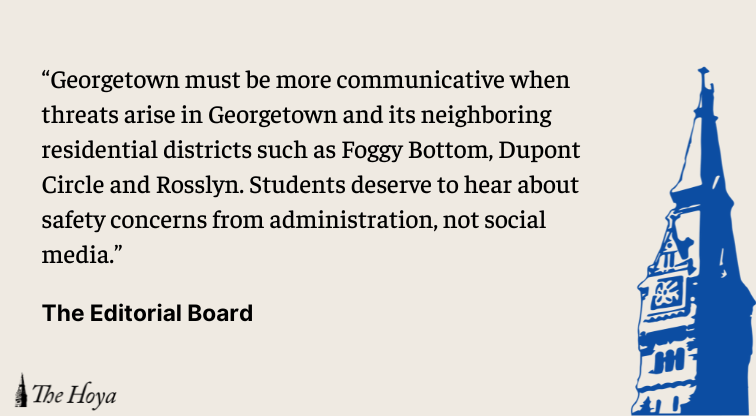As students, staff and faculty settle into the semester, campus security and safety are on many Georgetown University community members’ minds.
The topic is especially relevant since a homicide suspect, Christopher Haynes, escaped from police custody at the George Washington University (GW) Hospital on Wednesday, Sept. 6. This escape provoked a manhunt in both the Foggy Bottom and Georgetown neighborhoods.
Although the hospital is less than two miles away from Georgetown’s front gates, the university never informed Hoyas of Haynes’ escape. As of Sept. 14, Haynes has not been located.
Georgetown employs an extensive emergency communication network known as HOYAlert, but this network went unused. Many students found out about the potential threat through social media or by word of mouth.
Julia Krushelnycky (SFS ’27) said she was surprised at the lack of communication between Georgetown University Police Department (GUPD) and students, staff and faculty over the incident.
“I felt mostly safe on campus, but I was surprised by the lack of notice from GUPD about the situation. I first heard about the situation from a family friend in the area who assumed that the school would have communicated the situation to me,” Krushelnycky said in an interview with The Hoya.
This is unacceptable considering the escapee’s proximity to campus.
A university spokesperson said GUPD increased patrols following the incident last week following directives from the Metropolitan Police Department (MPD).
“In the case of the incident last week at GW Hospital, GUPD was monitoring the situation closely with MPD and, out of an abundance of caution, increased patrols at the perimeter of campus. At the time of the incident there was not an indication of a specific threat to campus,” a university spokesperson wrote in an email to The Hoya.
However, the university did not communicate increased patrols to students, creating worry on campus.
The Editorial Board demands the university acknowledge this lapse in judgment and commit to prioritizing security-related transparency in the future.
A university spokesperson said that when there are safety incidents on campus, GUPD takes additional measures to keep the campus community safe such as increasing patrols, increasing signage, sending messages out to the campus community and offering additional, voluntary training for relevant safety staff to ensure the safety of the community.
In addition, many students are aware of the tragic recent events at the University of North Carolina (UNC), where a gunman opened fire, killing one professor. The multitude of safety concerns in higher education nationwide has forced students to reevaluate the safety measures implemented on their own campuses
Following the UNC shooting, no Georgetown university communications were released clarifying active shooter protocols on campus.
Professor Maraam Dwidar, who is in her first semester at Georgetown after teaching at several other institutions, said the university’s active shooter response plan is not made clear to staff during onboarding.
“It says a lot that I cannot tell you enough detail about the active shooter policy or sort of any policy in response to threats on campus, except that I know they exist and that I know that there are trainings faculty can take, but that they are not required,” Dwidar said.
The Editorial Board calls on Georgetown to mandate active shooter training for all students and university employees. Currently, GUPD offers voluntary Zoom training, but this is not enough.
The university has offered optional active shooter training since 2016, working with more than 100 campus offices and thousands of community members. Since this program is not mandatory, it has not reached all necessary parties.
However, there is a silver lining to Georgetown’s security measures when compared to other universities.
“Every institution that I have been at — and this is my third educational institution as a teacher — hasn’t really had a cohesive policy,” Dwidar said. “And I think that Georgetown actually has the best one in the sense that I know that it exists and I know that there are trainings available to people that want to undertake them.”
This optional training instructs participants to follow “Run, Hide, Fight” protocol in the event of a shooting.
“We definitely get messaging and information, but it’s not communicated clearly and consistently enough,” Dwidar added.
In addition to offering active shooter training, Georgetown has equipped most but not all classrooms with intruder deterrent locks.
“Most Main Campus classrooms have been upgraded with intruder deterrent locks. In the case of a shelter-in-place response for an active threat situation, the red button on these door locks can be used to secure you and your class and can only be unlocked from the inside by turning the door handle or with a key issued to GUPD and emergency personnel,” the university spokesperson wrote.
Although the university claims this is an ongoing project, the Editorial Board insists that this project be prioritized and completed expeditiously.
The Editorial Board strongly recommends that the Georgetown community voice its dissatisfaction with the lack of clear messaging from GUPD regarding on-campus safety. Georgetown must be more communicative when threats arise in Georgetown and its neighboring residential districts such as Foggy Bottom, Dupont Circle and Rosslyn. Students deserve to hear about safety concerns from administration, not social media.
Georgetown must comprehensively update its security infrastructure. This includes installing intruder deterrent doors in all academic buildings on campus, mandating active shooter training and above all, prioritizing direct communication with university personnel and students.
The Hoya’s Editorial Board is composed of six students and is chaired by the opinion editors. Editorials reflect only the beliefs of a majority of the board and are not representative of The Hoya or any individual member of the board.














